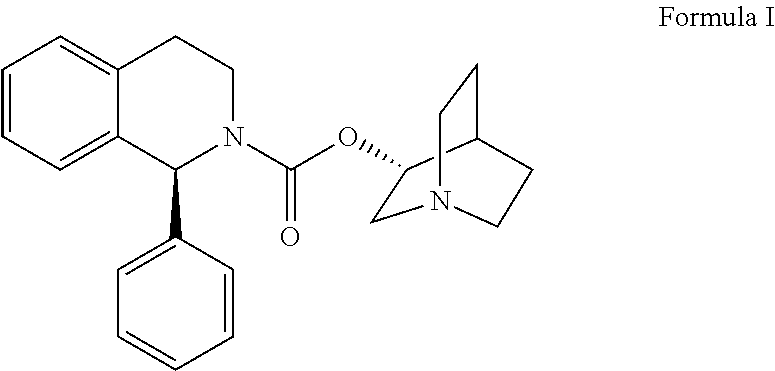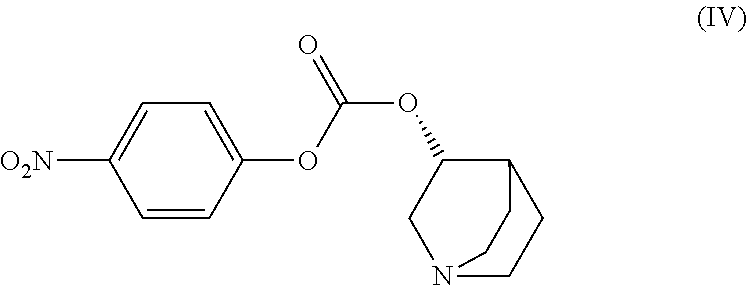Method for the preparation of solifenacin and intermediate thereof
a technology of solifenacin and solifenacin, which is applied in the field of preparation of solifenacin and its intermediate, can solve the problems of unsafe process handling at industrial level, longer time, and inability to process industrially, so as to reduce the exposure of production executives and reduce the turn around time of the total time cycle
- Summary
- Abstract
- Description
- Claims
- Application Information
AI Technical Summary
Benefits of technology
Problems solved by technology
Method used
Image
Examples
example 1
Preparation of Solifenacin Succinate of Formula (VI)
[0154]To a stirred solution of (3R)-quinuclidin-3-ol (25 gm) in dimethylformamide (175 ml) was added bis-(4-dinitrophenyl)carbonate (83.83 gm) with stirring at 25-30° C. under nitrogen atmosphere. The reaction mass was stirred at 25-30° C. for 2-3, hours. Upon completion of this reaction by HPLC, (1S)-1-phenyl-1,2,3,4-tetrahydroisoquinoline (41.0 gm) was added to resultant brown colored reaction solution and further stirred at 25-30° C. for 3-4 hrs. After completion of the reaction (monitored by HPLC), the reaction solution was diluted with water (250 ml) and the pH of the solution was adjusted to 1-2 using concentrated hydrochloric acid. The resulting reaction solution was extracted with diisopropylether (300 ml×2) to separate the nitro-phenol.
[0155]The aqueous layer was then extracted with dichloromethane (300 ml) and dichloromethane layer was separated and diluted with 200 ml water. The pH of the biphasic mixture was adjusted to...
example 2
Preparation of Solifenacin Succinate of Formula (VI)
[0157]To a stirred solution of (3R)-quinuclidin-3-ol (5 gm) in dry pyridine (30 ml) was added bis-(4-dinitrophenyl)carbonate (17.5 gm) with stirring at 25-30° C. under nitrogen atmosphere. The reaction mass was stirred at 25-30° C. for 2-3 hours. Upon completion of the reaction by HPLC, (1S)-1-phenyl-1,2,3,4-tetrahydroisoquinoline (7.5 gm) was added to resultant brown colored reaction solution and further stirred at 25-30° C. for 3-4 hrs. After completion of the reaction (monitored by HPLC), the reaction solution was diluted with water (100 ml) and the pH of the solution was adjusted to 1-2 using concentrated hydrochloric acid. The resulting reaction solution was extracted with diisopropylether (60 ml×2) to separate the nitro-phenol.
[0158]The aqueous layer was then extracted with dichloromethane (60 ml), and dichloromethane layer was separated and diluted with 40 ml of water. The pH of the biphasic mixture was adjusted to 9-10 with...
example 3
Preparation of Solifenacin Succinate of Formula (VI)
[0159](3R)-quinuclidin-3-ol (1.0 gm) of was dissolved in tetrahydrofuran (15 ml) and dry pyridine (1.0 ml) with stirring. Bis-(4-dinitrophenyl)carbonate (3.82 gm) was added to the above solution at 25-30° C. After completion of the reaction, (1S)-1-phenyl-1,2,3,4-tetrahydroisoquinoline (1.5 gm) was added to the resulting brown reaction solution and then stirred till completion of the reaction. Upon completion of the reaction, the reaction solution was diluted with water (20 ml) and the pH of the solution was adjusted to 1-2 using concentrated hydrochloric acid. The resulting solution was extracted with diisopropylether (12.0 ml×2) to separate the nitro-phenol.
[0160]The aqueous layer was separated and further extracted with dichloromethane (12 ml×2). The dichloromethane layer was diluted with water (8 ml) and pH of the resulting mixture was adjusted to 9-10 using ammonium hydroxide solution. The aqueous layer was separated from orga...
PUM
| Property | Measurement | Unit |
|---|---|---|
| temperature | aaaaa | aaaaa |
| temperature | aaaaa | aaaaa |
| chiral purity | aaaaa | aaaaa |
Abstract
Description
Claims
Application Information
 Login to View More
Login to View More - R&D
- Intellectual Property
- Life Sciences
- Materials
- Tech Scout
- Unparalleled Data Quality
- Higher Quality Content
- 60% Fewer Hallucinations
Browse by: Latest US Patents, China's latest patents, Technical Efficacy Thesaurus, Application Domain, Technology Topic, Popular Technical Reports.
© 2025 PatSnap. All rights reserved.Legal|Privacy policy|Modern Slavery Act Transparency Statement|Sitemap|About US| Contact US: help@patsnap.com



